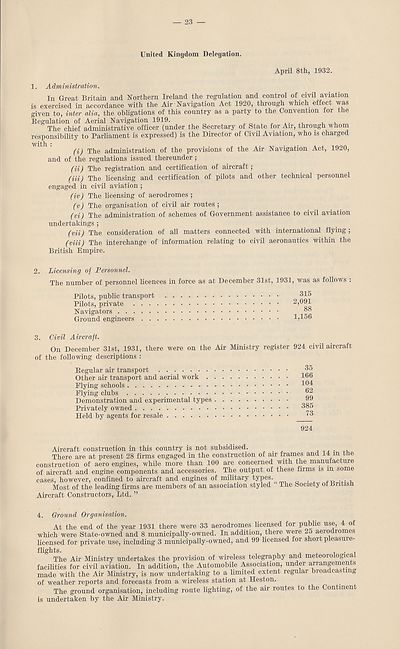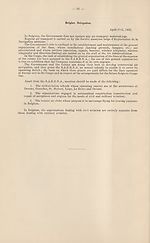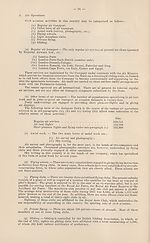Armament > Air Commission : collection of replies to the questionnaires concerning the organisation of national civilian forces (document Conf. D./C.A.6 - March 18th, 1932) (document Conf. D./C.A.7 - March 22nd, 1932)
(23)
Download files
Complete book:
Individual page:
Thumbnail gallery: Grid view | List view

— 23
United Kingdom Delegation.
April 8th, 1932.
1. Administration.
In Great Britain and Northern Ireland the regulation and control of civil aviation
is exercised in accordance with the Air Navigation Act 1920, through which effect was
given to, inter alia, the obligations of this country as a party to the Convention tor the
Regulation of Aerial Navigation 1919. „ o,. , a • ^ v. u
The chief administrative officer (under the Secretary of State for An, thiough whom
responsibility to Parliament is expressed) is the Director of Civil Aviation, who is charged
(i) The administration of the provisions of the Air Navigation Act, 1920,
and of the regulations issued thereunder ;
(ii) The registration and certification of aircraft;
(Hi) The licensing and certification of pilots and other technical personnel
engaged in civil aviation ;
(iv) The licensing of aerodromes ;
(v) The organisation of civil air routes ;
(vi) The administration of schemes of Government assistance to civil aviation
undertakings ;
(vii) The consideration of all matters connected with international flying ;
(viii) The interchange of information relating to civil aeronautics within the
British Empire.
2. Licensing of Personnel.
The number of personnel licences in force as at December 31st, 1931, was as follows :
Pilots, public transport
Pilots, private . . .
Navigators
Ground engineers . .
315
2,091
88
1,156
3. Civil Aircraft.
On December 31st, 1931, there were on the Air Ministry register 924 civil aircraft
of the following descriptions :
Regular air transport
Other air transport and aerial work . .
Flying schools
Flying clubs
Demonstration and experimental types .
Privately owned
Held by agents for resale
35
166
104
62
99
385
73
924
Aircraft construction in this country is not subsidised.
There are at present 28 firms engaged in the construction of air frames and 14 m t le
construction of aero engines, while more than 100 are concerned with the manufacture
of aircraft and engine components and accessories. The output of these firms is m some
cases, however, confined to aircraft and engines of military types. ... ,
Most of the leading firms are members of an association styled The Society ot-Kritisn
Aircraft Constructors, Ltd. ”
4. Ground Organisation.
At the end of the year 1931 there were 33 aerodromes licensed for Public use, 4 of
which were State-owned and 8 municipally-owned. In addition, there were 2o aero romes
licensed for private use, including 3 municipally-owned, and 99 licensed foi short p easure-
flights. . ,
The Air Ministry undertakes the provision of wireless telegraphy and meteoio ogica
facilities for civil aviation. In addition, the Automobile Association, under arrangemen s
made with the Air Ministry, is now undertaking to a limited extent regular bioa cas i g
of weather reports and forecasts from a wireless station at Heston.
The ground organisation, including route lighting, of the air routes to the Continent
is undertaken by the Air Ministry.
United Kingdom Delegation.
April 8th, 1932.
1. Administration.
In Great Britain and Northern Ireland the regulation and control of civil aviation
is exercised in accordance with the Air Navigation Act 1920, through which effect was
given to, inter alia, the obligations of this country as a party to the Convention tor the
Regulation of Aerial Navigation 1919. „ o,. , a • ^ v. u
The chief administrative officer (under the Secretary of State for An, thiough whom
responsibility to Parliament is expressed) is the Director of Civil Aviation, who is charged
(i) The administration of the provisions of the Air Navigation Act, 1920,
and of the regulations issued thereunder ;
(ii) The registration and certification of aircraft;
(Hi) The licensing and certification of pilots and other technical personnel
engaged in civil aviation ;
(iv) The licensing of aerodromes ;
(v) The organisation of civil air routes ;
(vi) The administration of schemes of Government assistance to civil aviation
undertakings ;
(vii) The consideration of all matters connected with international flying ;
(viii) The interchange of information relating to civil aeronautics within the
British Empire.
2. Licensing of Personnel.
The number of personnel licences in force as at December 31st, 1931, was as follows :
Pilots, public transport
Pilots, private . . .
Navigators
Ground engineers . .
315
2,091
88
1,156
3. Civil Aircraft.
On December 31st, 1931, there were on the Air Ministry register 924 civil aircraft
of the following descriptions :
Regular air transport
Other air transport and aerial work . .
Flying schools
Flying clubs
Demonstration and experimental types .
Privately owned
Held by agents for resale
35
166
104
62
99
385
73
924
Aircraft construction in this country is not subsidised.
There are at present 28 firms engaged in the construction of air frames and 14 m t le
construction of aero engines, while more than 100 are concerned with the manufacture
of aircraft and engine components and accessories. The output of these firms is m some
cases, however, confined to aircraft and engines of military types. ... ,
Most of the leading firms are members of an association styled The Society ot-Kritisn
Aircraft Constructors, Ltd. ”
4. Ground Organisation.
At the end of the year 1931 there were 33 aerodromes licensed for Public use, 4 of
which were State-owned and 8 municipally-owned. In addition, there were 2o aero romes
licensed for private use, including 3 municipally-owned, and 99 licensed foi short p easure-
flights. . ,
The Air Ministry undertakes the provision of wireless telegraphy and meteoio ogica
facilities for civil aviation. In addition, the Automobile Association, under arrangemen s
made with the Air Ministry, is now undertaking to a limited extent regular bioa cas i g
of weather reports and forecasts from a wireless station at Heston.
The ground organisation, including route lighting, of the air routes to the Continent
is undertaken by the Air Ministry.
Set display mode to:
![]() Universal Viewer |
Universal Viewer | ![]() Mirador |
Large image | Transcription
Mirador |
Large image | Transcription
Images and transcriptions on this page, including medium image downloads, may be used under the Creative Commons Attribution 4.0 International Licence unless otherwise stated. ![]()
| Permanent URL | https://digital.nls.uk/195422012 |
|---|
| Shelfmark | LN.IX |
|---|
| Description | Over 1,200 documents from the non-political organs of the League of Nations that dealt with health, disarmament, economic and financial matters for the duration of the League (1919-1945). Also online are statistical bulletins, essential facts, and an overview of the League by the first Secretary General, Sir Eric Drummond. These items are part of the Official Publications collection at the National Library of Scotland. |
|---|---|
| Additional NLS resources: |
|

